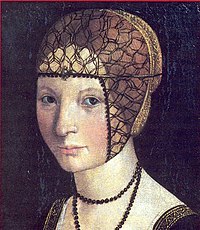Anne d'Alençon

Anna von Alençon (born October 30, 1492 , † October 18, 1562 ) was mistress of La Guerche in her own right and was Margravine of Montferrat by marriage . From 1518 until her death she ruled Montferrat as regent for her son Boniface IV.
biography
Anna was the third child of René , Duke of Alençon , and his second wife, Margaret of Lorraine-Vaudémont . Her father died two years after she was born. She was 1501 with Wilhelm XI. of Montferrat and married him on October 31, 1508, the day after her 16th birthday, in the church of Saint-Sauveur in Blois . She had three children from her husband:
- Maria (1509-1530),
- Margherita (1510–1566),
- Bonifacio (1512–1530), Wilhelm's successor
In 1517 their eldest daughter was betrothed to Federico II Gonzaga , who later became Margrave and Duke of Mantua . However, the marriage contract was annulled after Federico accused Maria of attempting to poison his mistress Isabella Boschetti, wife of the Count of Calvisano.
In 1518, with the death of Wilhelm XI, Bonifatius inherited the margraviate. Anna became regent for her six-year-old son until his unexpected death in June 1530, but was also included in the government of the margraviate afterwards. Her son's heir was her brother-in-law Johann Georg (Giovanni Giorgio del Monferrato), Commendatarabb of Lucedio and (not consecrated) Bishop of Casale .
Boniface's death also reactivated Federico Gonzaga's interest in marriage to Maria. After her death in September 1530, he turned to her sister Margherita, whose hand he received in October 1531. In 1533 Johann Georg died without a legitimate heir (he only left an illegitimate son), so that a dispute about the succession in Montferrat, an imperial fiefdom, broke out. The applicants were Federico Gonzaga, the Margrave of Saluzzo and the House of Savoy , who were also able to verify their claims. In 1536, Emperor Charles V transferred the fiefdom of the only surviving family members, Margherita, and thus Federico Gonzaga, and Anna von Alençon de facto came to the fore again as regent . Federico Gonzaga died in Marmirolo in 1540 , his heir was his six-year-old son Francesco III. Gonzaga in both Mantua and Montferrat. Margherita and her brother-in-law, Cardinal Ercole Gonzaga, took over the reign .
Anna of Alençon later withdrew from public life and entered the convent of the Dominican Sisters of Catherine of Siena , which was located next to her palace in Casale Monferrato . She died on October 18, 1562, shortly before her seventieth birthday.
The Alençon legacy
Anna's brother, Duke Charles IV of Alençon , died in Lyon in 1525 after the Battle of Pavia . He left Anna and her sister Françoise his personal property (which was unsuccessfully challenged by Charles' widow Margarete of Navarre ). Anna, in turn, wanted to pass the property on to Isabella Gonzaga, the eldest daughter of Federico and Margherita, who, however, rejected him. Margherita managed to pass the inheritance on to her third son, Luigi Gonzaga , who later became Duke of Nevers and founder of the French line of the family.
literature
- Piano, Pierluigi, Anne d'Alençon, Circolo culturale “I Marchesi del Monferrato”, (online) (it.)
| personal data | |
|---|---|
| SURNAME | Alençon, Anne d ' |
| ALTERNATIVE NAMES | Alençon, Anna from |
| BRIEF DESCRIPTION | Mistress of La Guerche, Margrave of Montferrat |
| DATE OF BIRTH | October 30, 1492 |
| DATE OF DEATH | October 18, 1562 |
